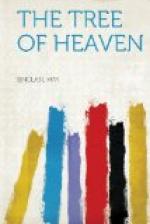“That’s why violence is right.
“’O Violenza, sorgi, balena in questo cielo Sanguigno, stupra le albe, irrompi come incendio nei vesperi, fa di tutto il sereno una tempesta, fa di tutta la vita una bataglia, fa con tutte le anime un odio solo!’
“There’s no special holiness in violence. Violence is right because it’s necessary.”
“You mean it’s necessary because it’s right.”
Austen Mitchell spoke. He was a sallow youth with a broad, flat-featured, British face, but he had achieved an appearance of great strangeness and distinction by letting his hay-coloured hair grow long and cultivating two beards instead of one.
“Violence,” he continued, “is not a means; it’s an end! Energy must be got for its own sake, if you want to generate more energy instead of standing still. The difference between Pastism and Futurism is the difference between statics and dynamics. Futurist art is simply art that has gone on, that, has left off being static and become dynamic. It expresses movement. Owen will tell you better than I can why it expresses movement.”
A light darted from the corner of the room where Paul Monier-Owen had curled himself up. His eyes flashed like the eyes of a young wild animal roused in its lair.
Paul Monier-Owen was dark and soft and supple. At a little distance he had the clumsy grace and velvet innocence of a black panther, half cub, half grown. The tips of his ears, the corners of his prominent eyes, his eyebrows and his long nostrils tilted slightly upwards and backwards. Under his slender, mournful nose his restless smile showed the white teeth of a young animal.
Above this primitive, savage base of features that responded incessantly to any childish provocation, the intelligence of Monier-Owen watched in his calm and beautiful forehead and in his eyes.
He said, “It expresses movement, because it presents objects directly as cutting across many planes. To do this you have to break up objects into the lines and masses that compose them, and project those lines and masses into space on any curve, at any angle, according to the planes you mean them to cross, otherwise the movements you mean them to express. The more planes intersected the more movement you get. By decomposing figures you compose movements. By decomposing groups of figures you compose groups of movement. Nothing but a cinema can represent objects as intact and as at the same time moving; and even the cinema only does this by a series of decompositions so minute as to escape the eye.
“You want to draw a battle-piece or the traffic at Hyde Park Corner. It can’t be done unless you break up your objects as Mitchell breaks them up. You want to carve figures in the round, wrestling or dancing. It can’t be done unless you dislocate their lines and masses as I dislocate them, so as to throw them all at once into those planes that the intact body could only have traversed one after another in a given time.




